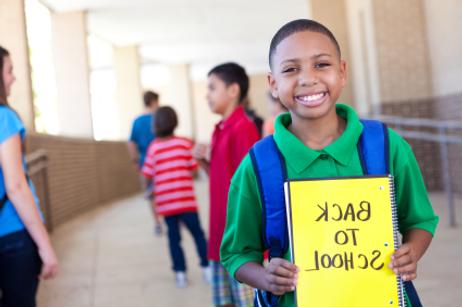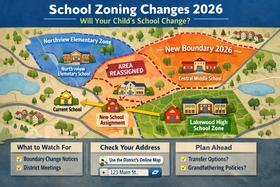For many families nationwide, Labor Day marks the end of summer – and the start of a new school year. Heading back to school can inspire many emotions from kids and parents alike, from anxiety over meeting new students and teachers to excitement over purchasing new supplies and clothing. While every family approaches the back-to-school process a bit differently, there is a common thread running through nearly every household in the nation this time of year – a flurry of activity that can sometimes be difficult to manage. The good news is that parents and children can take plenty of positive steps to make the transition back to school much smoother.
Stock Up on Supplies
Back-to-school shopping means much more than stocking up on a few pencils and a ream of notebook paper. Most parents engulf themselves in a task that involves purchasing new clothing, checking items off the school supply list from school, and scouring the sales for the best deals. The following shopping tips will make the entire process much more efficient overall.
School Clothes
Organized Home recommends planning before shopping to make the actual trips to the store as fast, easy, and budget-friendly as possible. Begin by assessing each child's current clothing situation to determine what school clothing needs to be purchased. Get rid of all the clothing that no longer fits or is torn or stained beyond repair. Toss what can be reused, donate the rest, or stage your garage sale to make a little extra cash for the school supply shopping. Once you have discarded everything that can no longer be used, making lists of the needed items will be easier. Once the list is completed, take advantage of the end-of-season sales that provide big bargains on essentials. If you take children with you for clothing shopping, ensure they understand the budget upfront to avoid any confrontations in the store. Kaboose suggests allowing older children to indulge in a single trendy item before the start of the year, if it fits your budget, to raise their enthusiasm about returning to the classroom in style.
School Supplies
Most children get very excited about returning to school when they begin shopping for all the new supplies they will take with them. Begin by purchasing a new backpack for the year so all the supplies can go inside the pack as they are purchased. If your school provides a detailed school supply list, print it off the school website before you head to the store. Some of the larger discount chains also provide lists in their school supply departments to make it easier for parents. Take advantage of these once-a-year sales to stock up on writing utensils, paper, erasers, and notebooks for the home study center. Once all the supplies are purchased, label everything going into the classroom – including new lunch boxes, backpacks, and jackets – to avoid losses of essential items throughout the year.
This video offers a look at the first day of kindergarten.
Regain Routine
The lazy days of summer provide a relaxing getaway from the rigors of the school year, but they can also make it a challenge to jump back into the routine when fall hits. Make the transition easier on kids by slowly moving back to a school bedtime and setting the alarm a little earlier each morning. A gradual phase-in of the school schedule is often easier for kids.
Education.com also recommends talking with children about the schedule changes before the start of the school year. In many cases, school days are just the beginning—extracurricular activities often take up some evening and weekend time. By preparing children for the change and letting them know what to expect, the children not only make the transition more accessible but also begin to look forward to the many fun activities to come.
Calendar Station
To help parents keep track of the busier schedule, create a calendar station in a central location of the home. Many families use a corner of the kitchen for this purpose since this is typically where families spend most of their time. Use a calendar with large enough boxes to write in each day’s activities and color code entries for each separate family member. Organized Home suggests adding some items to the calendar station: school lunch menus, sports schedules, and class assignment sheets. Adding a bulletin board or magnetic board can make it easier to post these essential items in plain view.
Positive Habits
Create good habits that will make busy school mornings run more smoothly. Teach children to lay out clothing the night before and even fill water bottles or pack lunches to store in the refrigerator until the following day. Have a send-off station near the door that holds backpacks, keys, important papers, and any other items that must be taken out the following day. Pack up musical instruments or sports equipment the night before so they are also ready for after-school activities.
Organize a Study Space
When children come home from the classroom, it’s homework time. Make sure this time is as productive and efficient as possible by creating a designated homework space in the home. Younger children may need a place to work near a parent to get help with assignments quickly. A room at the kitchen table or in a corner of the family room may be the perfect space. Older children prefer to study in a quiet spot like a bedroom or office. Stock the homework station with necessary supplies like pencils, crayons, paper, scissors, and glue sticks. Ensure proper lighting and a comfortable chair to make the time in that space as pleasant as possible. Older children may appreciate their whiteboard or bulletin board to post homework assignments and reminders about upcoming tests and projects.
Re-Train the Brain
After two or three months of watching television and playing at the pool, most kids need a jumpstart to get their thinking skills up to par. Fortunately, exercising the brain doesn’t have to be as dull as completing worksheets at the kitchen table on a balmy summer afternoon. Instead, make brain training a fun prospect by incorporating the following activities into your summer days:
Reading Routines—Most children love trips to the library, where they can find books that interest them. Many libraries also have summer reading programs that offer prizes for children who complete a set amount of reading throughout the season. If it’s too late to make summer reading a regular part of your routine, a trip to the library over Labor Day weekend can recharge your child’s love of reading and give them a few interesting titles to start the school year.
Board Games—In the age of video gaming, board games have sadly become passe in many homes today. However, a lively game of Life, Monopoly, or Scrabble can get thinking skills back up to snuff. Plan to spend at least one evening on your last weekend of summer indulging in one of your favorite board games as a family. Card games and jigsaw puzzles can also work to retrain the brain before classes start up again.
Online Games—For diehard gamers who just can’t tear their eyes away from the screen, there are many online games that inspire thinking and logical reasoning skills. Saving.com suggests online options like Geo Challenge, Word Challenge, and online Sudoku to get kids back in the thinking game. Many of these free games can be as fun for adults as kids.
This video offers a look at the first day of high school.
Keep it Positive
Keep the process as positive as possible for children who don’t relish the idea of going back to school. Kaboose suggests thinking about everything a child likes about school – whether eating in the lunchroom, playing with friends at recess, or meeting a new teacher – and focusing on those things as you prepare for the upcoming year. If your child has a new outfit or haircut, talk about how much fun it will be for friends to see the new look. Make school supply shopping an event, and allow your child to pick out items in his favorite color or style whenever possible.
Let your child know that you value the learning process. Talk about how important time spent in the classroom can be for other things he wants to do in life. Let your child see you learning, whether by researching topics on the Internet or heading to the library to find books on a subject. Talk about how you use concepts learned in school every day, from the math you use in recipes to the history you learned while watching the news on television.
If your child has anxiety about the new year, talk about his feelings. Listen to what he has to say and acknowledge his feelings as legitimate. Talk about ways to ease his anxiety, whether to see a friend or two before the start of the school year or take advantage of an orientation day to meet the teacher and see the classroom. Let him know that he is expected to have first-day “jitters” and that the nervousness will probably ease off quickly once he gets the first day.
For Newbies
When children start school for the first time, the first-day jitters become much more pronounced. Whether you just moved to a new area or your child is moving up to middle or high school, the fear of the unknown is a genuine anxiety. Kaboose suggests that parents take children to the new school before the first day so they can learn the school route and see the building for themselves. Talk about how the child will get to school each day, whether by walking, bus, or carpool and what will happen at the end of the day. Point out the precise spot on the school grounds where he will catch the bus or meet you when school gets out.
If you can enter the school before the first day, take advantage of it. Many schools have orientation or meet-and-greet days to allow students and parents to see the classroom and meet the teacher. Do not underestimate the importance of this event, even for older children starting middle or high school. Simply knowing how to get around the building can do much to ease first-day anxiety. If unsure about orientation dates, check the school’s website or call the main office.
If your child starts kindergarten, reading books about starting school together can also be helpful. Many great picture books illustrate a school day and how a child can handle possible issues. Talk to your child about the teacher's role in the classroom and how he can go to the teacher for everything from a bathroom break to a bully bothering him on the playground. Ensure your child can locate his classroom, the bathroom, and the lunchroom if he eats lunch at school.
The beginning of school is an exciting time, but it can also be a time filled with stress and anxiety – for both children and parents. The business of the season, as well as the fear of the unknown, can compound to make the event a challenging one for the entire family. Fortunately, you can take plenty of steps to prepare for the big day and ensure everyone in the household eases into the transition as smoothly as possible. With the proper preparation, everyone can look forward to a new school year with excited anticipation rather than fear and apprehension.
Questions? Contact us on Facebook. @publicschoolreview












